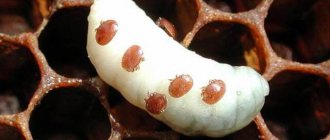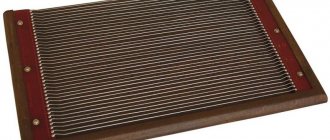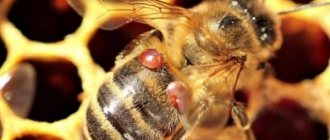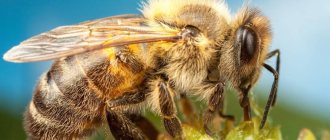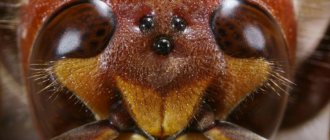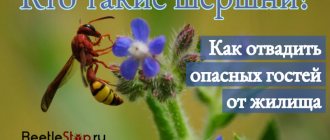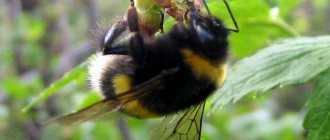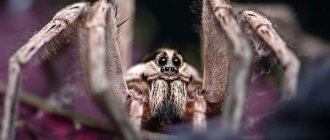Blog articles Beekeeping
Beekeeping
Economics of beekeeping
Beekeeping news in Russia
Beekeeping news in the world
Honey
Propolis
Bee bread
Zabrus
Royal jelly
In the world about bees
Apiary
Bees
News from honey fairs
From the history of beekeeping
- Wasps? Let's get to know each other better
- Why are wasps dangerous in the apiary?
- Hornets are the mighty enemies of bees.
- How to get rid of wasps in an apiary. Methods and methods of struggle
- We fight wasps with traps
Wasps? Let's get to know them better
These amazing insects have been familiar to us since childhood. Most normal people feel fear and disgust when they see them. Part of humanity has heard about the painful bites of Hymenoptera and is fighting wasps with all their might. Some are “lucky” to experience this pleasure for themselves. Striped, rather graceful representatives of the family have many close relatives: bees, ants, bumblebees, ichneumon riders, sawflies. Fun fact: scientists tend to believe that bees and ants are the ancestors of one of the ancient species of wasps. Long evolution has taught them to feed exclusively on flower nectar. Reputable scientists explain the appearance of ants as follows: they lost their wings during their development. Australian bulldog ants have a stinger and potent venom to support this theory.
Among the individuals we are considering, there are many loners. There are even more inhabitants living in groups. We are interested in those that constantly interfere with honey collectors. First of all, they are enemies of the apiary and beekeeping in general. As a rule, they also love to collect sweet treats. Therefore, they are often seen on large receptacles. There is an opinion: they consume the meat (so to speak) of our favorites. Is it so? Biologists say that they need someone else’s flesh not for their own nutrition, but for feeding their offspring. The larvae are, indeed, unusually gluttonous and require a “meat” diet.
Prevention of attacks by wasps and hornets
You can minimize encounters with wasps and hornets in nature or at your dacha by observing the following rules:
- Strong aromas attract the attention of wild insects. Perfume should not be used.
- Bright multi-colored clothing with color patterns will serve as a guide for wasps to attack.
- Fruits, sweets, and soda consumed at a picnic can attract a lot of wasps and hornets.
- Walking barefoot through tall grass in unfamiliar areas can cause accidental damage to a wasp nest. The consequences can be dire.
- When attacking an insect, you should not wave your arms or make sudden movements, provoking its more aggressive behavior.
If it was not possible to avoid single or multiple bites of hornets and wasps, to avoid severe intoxication of the body, you should immediately seek help from a medical facility.
Video: Fighting wasps in the apiary
In everyday life, ordinary people observe paper wasps. They love to steal some of the sweet product on occasion. They calmly climb into an open hive during inspection. They take tribute impudently and shamelessly. Defender bees do not always attempt to protect a home. They are weaker physically. Nevertheless, attempts to resist and fight are made regularly.
Wasps vs bees
The apiary is bred to produce tasty, healthy honey. Bees work every day collecting pollen. And then they turn it into a viscous aromatic mass. Honey serves as food for them, but also attracts the attention of wasps.
Experts cite data that 50 large hornets destroy a bee family of 40 thousand individuals in 3 hours. They eat honey, larvae, and take adult bees to feed their young.
The attacks of wasps, called bee wolves, in the apiary of bees are no less harmful. The advantages in size are insignificant, but the aggressive disposition wins. Predators sense the apiary several tens of kilometers away and purposefully move into the hive. After managing a swarm of pests, the beekeeper is left with only damage.
Wasps in the apiary
Paper wasps are less aggressive, but sometimes they also allow themselves to make regular raids on bee colonies. To avoid troubles and preserve the apiary, they begin to take care of the safety of insects in early spring.
Why are wasps dangerous in the apiary?
Constant raids on the apiary farm ultimately end in the same way: she grabs the victim that turns up and goes home! If this were the only reason for hostility towards them, it wouldn’t be so bad. Even with a massive attack, with tangible damage, the negative is less compared to a hidden threat. The sad thing is that predators (this nickname has stuck tightly to them) have invasive diseases similar to the bee breed. With careful care there is no guarantee of basic safety. There is only one conclusion: declare a merciless war on the wasps. It is clear that we will not defeat everyone, but it is necessary to strive for the goal and fight.
Preventative spring measures for the appearance of wasps in the fall
To prevent a pest invasion, it is necessary to take preventive measures in the spring that will help avoid large losses of bees in the fall.
To do this, it is important to timely track the movement of wasps and choose the right site for installing an apiary.
The right choice of terrain for placing an apiary
It is best to install a bee hive in an area with dense soil. The apiary should be located in an area with thick grass cover. Pests love to settle on embankments and vacant lots in ravines; they are especially attracted to clay or sandy soil, where it is easy to make burrows.
Timely tracking of the appearance and movement of wasps
You can get rid of insects by tracking them. In the spring, when the pest begins to move around the area allocated for the apiary, you need to follow it, so you can find a wasp nest even in dense thickets or on the top of a tree and take measures to destroy it.
Important! If there are sandy areas around the perimeter of the apiary, then they need to be dug up to a depth of 40 cm, which will help get rid of wasp nests.
Autumn is the most suitable time for the pest to become active, due to the fact that the wasp makes reserves for the winter. That is why the fight against insects must be comprehensive, because the collection of honey and the life of a bee swarm can depend on correctly carried out preventive measures, as well as timely care of the apiary.
Hornets are the mighty enemies of bees.
It is generally accepted that you need to know your enemy by sight. We have already met some of them. Hornets also cause trouble. They are larger and have impressive dimensions. Externally, they have a characteristic wide nape and dark red spots on the head. By the way, this enlarged creature has a rather peaceful disposition. His attacks on our fellow tribesmen are much less frequent.
The described “cuties” have powerful jaws. So strong that they rarely use their main trump card, but crush the chitinous cover of the victim in a matter of seconds. By the way, they have their own natural enemies: blackflies and dragonflies, and golden bee-eaters. While we scare away pest birds, we save dragonflies to fight hornets.
Wasp victories are determined by the following factors:
- They have two weapons for battle.
- The body structure is more flexible, elastic, and mobile.
- The sting does not have serrations, so it can sting several times.
- Its poison is more dangerous and is administered in larger quantities.
Searching for enemy nests
You can protect bees from wasps using drastic methods. If your apiary is regularly attacked by wasps, you need to look for a nest.
Wasp nest on the site
The bee wolf or European philanthus belongs to the family of sand wasps. Each individual lives separately. Nests, as such, are not built. They make holes to drag the prey there, lay an egg, and provide nutrition to the larva for the entire development cycle. Adults feed on nectar, plant juices, and honey. It is impossible to find a philant's nest with one immobilized victim. The solution is to kill wolves mechanically when they are found in the apiary. Inspect the area periodically.
Hornets are the largest representatives of wasps in our area, the main enemies of bees and smaller representatives of the wasp family. Hornets are social figures. They build huge nests, transmit signals to each other about danger and the presence of food. If one hornet discovers a hive of bees, there will be a swarm there within an hour. Large wasps build nests in trees, in the ground, under stones, thickets, under the roof of outbuildings, and in attics.
Finding a hornet's nest is not difficult if it is located on the territory of a garden, vegetable garden, or allotment. It is a large grey-brown cocoon that resembles a paper sphere. There are several methods of destruction - pour boiled water, polyurethane foam, douse it with gasoline to then burn it, sprinkle poison or lay out poisonous bait.
If ordinary wasps climb into the hive and make regular raids, you need to look for the nest of these insects and destroy them. Externally, a paper wasp hive is no different from a hornet's house; the average nest size does not exceed an average apple.
How to get rid of wasps in an apiary. Methods and methods of struggle
Whatever one may say, wasps are especially dangerous. At every opportunity, fight them and take advantage of every opportunity to destroy them. The accumulated experience indicates the sufficient effectiveness of many generally accepted methods of control.
The simplest solution to fight is to find and eliminate nests. They prefer places in attics, under awnings, in the space between roof sheathing and slate. In a word, adherents of secluded hiding places. If you tear down their construction and throw it into a bucket of water, consider it a good deed. Or burn it. After all, even adults and children are afraid of them. It's easy to say. Difficult to accomplish. Let's look at the procedure step by step. We remember the location. We carry out the operation in the dark, when the enemy is assembled but inactive. Carefully stretch the spacious plastic bag and pull the ball out of place. (It is supported by one single mounting leg). We tie it quickly and tightly. Next - a water procedure or an acquaintance with the properties of fire...
How to find and destroy a wasp's nest?
Finding a wasp nest in a forest or in rugged steppe terrain is a rather difficult task. It’s good if it turns out to be located right next to the apiary, and the beekeeper has the opportunity to detect it without additional means. More often, the wasp nest is located at a great distance, sometimes in inaccessible hollows or holes in the ground, and it can be very difficult to detect it without additional tricks.
An effective method for finding wasp nests is to mark the insects. To do this, the insect is caught with a net, a light and long red ribbon is carefully tied around its “waist”, after which the wasp is released. Usually within half an hour she returns to her nest, and thanks to the visible tape, she will be easy to follow. In this way, it is not difficult to identify even hard-to-see wasp nests on tall trees.
Video: How to properly deal with wasps in an apiary
More than once I came across situations when, not far from the point, I noticed wasps flying out of the underground shelters of “thieves of state property.” To be honest, for the first time I was stunned upon closer acquaintance. Believing that there were several creatures there, at most a dozen, I decided to accustom them to substance abuse. I took a can of Dichlorvos and at the same time grabbed an empty can of oil paint.
He carried out the execution in the evening twilight, judging sensibly that at this time the “sworn friends” would gather for the night. There was no limit to surprise when I let in a long stream of aerosol, then prudently covered the round hole with a can, pressing it down with my foot to be sure. There was a powerful roar, more like the distant sounds of a jet plane taking off in afterburner. I don’t know the exact number of inhabitants, but I have no doubt that a substantial colony lived there. Subsequently, he used such destruction more than once. This method of struggle worked flawlessly.
With increased attention from distant relatives to the hive inhabitants, sometimes it is enough to shorten the entrances, install standard barriers, attach additional verandas or cone stops.
We protect the apiary ahead of time: what needs to be done in the spring?
Even in the spring, when the life of a bee colony is just entering its active phase, measures must be taken to protect the hive from wasp attacks: these protective measures must be comprehensive and thought out in advance down to the smallest detail.
Firstly, you should choose the right place to place the apiary. Ideally, the area for this should be with dense chernozem soils, thick grass cover, the absence of ravines, embankments and wastelands with sandy or clayey bald spots (it is in such areas that female philantines make burrows and carry captured bees here).
If there are still small sandy areas near the apiary, it is useful to plow them up during the cold season in order to reduce the number of phylants emerging from their burrows onto the surface of the earth in the spring. Sometimes this helps save a huge number of bees, because in the spring the “bee wolves” simply will not hatch.
Secondly, in an already placed apiary around the perimeter of the territory, it can be useful to hang traps for wasps and hornets made from simple plastic bottles. Making such traps is not at all difficult, and at the same time they protect the bees quite well.
It is also useful to read: Interesting facts from the life of wasps and photographs of these insects
To make a trap, you will need a regular plastic bottle: the top third is cut off, bait is poured into the bottom of the bottle, and the separated top is turned upside down and inserted inside the bottom of the bottle. Wasps, attracted by the bait, climb into the trap through the neck, but are no longer able to get out.
You can use jam (preferably fermented or sour), beer, kvass, and mash as bait in traps. The more such traps are placed in the apiary, the more bees can be saved.
In addition, already in the spring it is useful to pay attention to emerging wasps and track their movements: sometimes this way you can find a wasp nest even in dense bushes and destroy it in a timely manner.
We fight wasps with traps
In fact, many beekeepers use numerous specialized traps to combat. There are thousands of descriptions on sites, so there is no point in dwelling on them too much. Some act through poisoned baits. Others are lured into a sort of “sauna” with high temperature. Attracted by the pleasant aroma, the wasps enter the trap, cannot get back out, and die from the heat. There are other tricks too. Thanks to critical comments, the industry has received sufficient attention from domestic and foreign manufacturers. Now there is a wonderful variety of necessary products on the shelves.
Why get rid of
Fighting wasps in the apiary is a mandatory measure to avoid irreparable consequences. After all, these insects can cause serious damage to the bee colony:
- wasps feed their larvae to bees;
- they penetrate the hive and take away honey and nectar;
- spread infectious diseases.
By turning a blind eye to the presence of a wasp nest and not protecting itself from the wasps, the beekeeper may be left without honey and without bees. Therefore, it is necessary to take appropriate measures to save bees from wasps, because the aggressive insect can destroy up to five bees every day.
In autumn, when it gets cooler, bees become less active. Wasps take advantage of this and attack them, stealing the bees' honey reserves for the winter. Wild insects are quite capable of destroying a weak bee colony.
Destruction methods
Both beekeepers and winemakers know how to deal with hornets and wasps: a board is smeared with wine, and when insects gather on it, another board is lowered on top. Or they boil meat with poisonous mushrooms to place it in an apiary or near a vineyard. Wasps are dying, as are birds and several other species of animals.
Trap on the hive
It is better to use legal methods, which are listed below.
Method one - spring
Open areas of soil without turf become nesting sites for wasps and solitary bees. Such areas always exist on the slopes of ravines and ditches, in road ditches, etc. The soil should be dug or plowed. In the spring, the philanthus, that is, the bee wolf, is a solitary wasp, the harm of which is exaggerated. And yet, a massive invasion of philates can cause trouble.
The hunting radius of a female philanthus is up to 5 km! Massive invasions occur in July.
Method two - traps
In order not to catch the bees themselves, the bait must be fermented:
- Wasps are not interested in the berries in the vineyard until they burst;
- After fermentation, any juice attracts wasps, but not bees.
Sticky traps are placed on hives. And the perimeter should be protected by traps made of plastic bottles.
Trap design
Let the material be transparent.
The neck should point inward. The container is filled to 1/4 volume. The mixture is prepared according to the table.
Not a single bee gets caught in the trap.
In autumn, at T = +7...+8 °C, traps are transferred to the covers of the hives. And you can fill them not with wine, but with water and honey. The calculation is made that bees do not fly for food in such weather.
Method three - limited access
Not a single individual wasp enters the hive through the entrance. Slots are used that form in the corners of the hive and near the bottom. Sometimes bees make repairs themselves, but the propolis needed for this is not always produced quickly. It is better to fix the problem using PVA glue mixed with sawdust.
The queen bee has a sting, and it is needed to get rid of any uninvited guests. But the “guest” must enter through one of the entrances. In autumn, at T = +5 °C and below, it is better to cover the entrances with a net.
Mesh or lattice
We are talking about a complete restriction of access, including for bees.
Method four - “targeted destruction”
Every wasp nest has an entrance. When the repellent is sprayed into the center for a long time, all individuals die. This operation is carried out wearing protective clothing and a mask.
Wasp hive
- If there are no flammable materials near the nest, use a blowtorch;
- The nest can be placed in a bag and cut off. The bag is immediately tied, and then the repellent is applied.
All actions must be carried out at night, when the wasps are inside the nest.
Beekeeping involves the use of a smoke cannon. It is useless against wasps.
Housing in the ground
You can place a tank of water under the paper nest: the tap hole and 2/3 of the nest are immersed in water. All earthen nests are filled with gasoline or diesel fuel.
Another method, with a fire hose, is presented in the video.
Chemicals
When the nest is removed, the surface is treated with “chemistry”. One of the best drugs is imidacloprid. Wasps do not develop immunity to it. Unfortunately, there is also a danger for bees: neonicotinoids can cause memory loss. An effective mixture contains 30-40 g of the drug per liter. Scotch tape with imidacloprid is also sold.
In Russia, imidacloprid has been used recently, but in Canada and the USA it is gradually being abandoned.
Traditional methods
There is a trivial method that works against ants: a sprig of tansy is placed in the hive. Wormwood and tansy have no effect on wasps.
meat trap
Serbian beekeeper Milan Čirović invented a trap that is placed on top of the hive:
- Cylinder;
- Cone mesh;
- Mesh cover;
- Wire;
- Bars;
- Bait (meat without poison).
The number of traps in the apiary is 2-3.
Cirovic says, “When you get rid of wasps by throwing them out of a net, they are already dead.”
How to make a trap
The easiest way to make a wasp trap is to use an old plastic bottle . The top part with the neck is cut off (the height of this part is up to 10-15 cm). The neck unfolds with the narrow part down and is tightly inserted into the bottle. The result is a narrow entrance through which it is difficult to get back out.
The trap is filled to a third or less with bait. It is used as:
- a mixture of water and honey, honey satiate;
- wine bite;
- fermented compote.
Honey feeding is used with great care to avoid the death of bees! The bottles are installed late in the evening and removed in the morning before the start of the bee summer. In order not to constantly be on duty in the apiary, it is preferable to use wine vinegar, which does not attract bees at all.
As the traps fill with dead wasps, they are cleaned and refilled with bait.
Another way to catch predator insects is to use a glass liter jar and a household plastic funnel . The two listed parts are fastened together with a rubber ring.
Inside, at the bottom of the jar, 20-30 g of sour fruit juice is poured. After which the jar is placed sideways on the lid of a hive. You can place it on the ground directly near the hives. Both wasps and flies readily accept such bait. Bees do not react to sour fruit juice - the device can be used around the clock.
After 3-5 days, the “catch” is filled with clean water. After destroying the pests, the resulting mass is poured into a cesspool, and the trap is filled with a fresh portion of bait and installed in place.
Preparatory protection measures in spring
If the apiary was recently established and there were no wasps before, they will not appear for at least one year. And in the spring you need to look for death in the hives. The visit of wasps is indicated by a sign: several families are weakened, and a lot of black, that is, “thin” death has appeared.
Black Podmore
The cause is lack of food, the consequence is death from hunger.
One wasp carries out 0.035 g of honey in one visit. And standard supplies do not exceed 10-15 kg.
What to do if you are bitten by a bee?
There can be only one answer to the question of how to get rid of wild bees: turning to specialists for help. These may be special services that will come and destroy all insects. Or you can simply find a beekeeper who would agree to take them to his apiary or simply take them away from your home.
In this case, you will remain unharmed, and your family will be safe.
How to get rid of bees if you are afraid that they might bite. In this situation, there are two options: either don’t go near them, or learn to tolerate bee stings painlessly.
A bee sting is quite unpleasant, and if the body is still sensitive to them, the consequences can be very serious. To reduce the risk of developing any complication, you must adhere to the following rules:
- After the bite, a sting remains. It must be carefully removed.
- Small pressing movements remove the poison that has penetrated the wound.
- The entire wound is treated with ethyl or ammonia. In extreme cases, you can treat it with apple cider vinegar.
- To prevent swelling, it is recommended to apply dandelion or mallow juice.
If there are a lot of bites, then you should drink a lot of liquid.
Neighbor bees often cause trouble, especially if the hives are located on a neighboring property. How can you scare bees away from your area in this case?
There are several ways to try to resolve the matter peacefully:
- fenced with a fence 2 meters high;
- ask to move the hives away from the site;
- plant fast-growing trees and shrubs;
- raise the hives to a height so that their flight path is higher than human height.
If neighboring bees are attracted to honey-bearing flowers and trees on your site, then you can try planting cloves, calendula, and peppermint near them. These plants repel insects with their scent.
If a peaceful conversation does not solve anything, and you are attacked by bees from the same neighbor, you will have to use extreme measures
It is important to remember that a hefty fine can be issued for deliberate damage to property, therefore, you need to act carefully so that no evidence is discovered
The first and safest method is only for bees, but not for your neighbor: place a bowl with the substance quinine on your property. The aroma will attract neighboring bees to the treat. After a bee tastes nectar with quinine, it will not make her feel bad. However, the honey produced will be very bitter and taste nasty.
Noticing this, the owner will soon close the production of beekeeping products, since it is more expensive for himself to sell honey with poor taste. This method is not harmful to health.
The second method is more extensive and destructive for bees: A poisonous insecticide is sprayed on the flowers and plants of your garden plot. But don’t go overboard and concentrate too much. Otherwise, bees carrying poisoned nectar into the lair will die before it is brought to the hive.
As a result, the entire bee family will die out after a day of such feeding. However, when contemplating such a radical struggle, you need to know that nature needs bees to give a new round of life to plants on earth. After all, if there are no bees nearby, then the apple tree on your site will not be able to bear fruit, the same applies to other fruit and berry crops.
In any case, a peace treaty with your neighbors should be your full salvation. Legislation will help solve the question of how to get rid of your neighbor’s bees and deal with biting bees.
Poisonous baits
An alternative to simple traps is the use of poisoned baits. Here are three proven methods:
Use of fly agaric mushroom . The fly agaric cap is thoroughly crushed and boiled for three minutes in a mixture of 100 g of honey and 250 ml of water. Poison should not be placed in the apiary during active summer! It is better to place the bait near the wasp colony. Then, after poisoning, the predators will have time to get to the nests and feed the bait to the larvae. As a result, the entire colony will die.
Read also: How to make a nucleus for bees with your own hands: drawings, dimensions, what it is
Attention: all work with fly agaric must be done with gloves.
Using dust . The event is held in the fall, when there is no active summer in the apiary. The hive entrances must be closed! During work, extreme care must be taken to ensure that bee colonies are not harmed. Deep plates are greased with a thin layer of honey and sprinkled with dust (DDT). Then the bait is placed in those places in the apiary that were most visited by female wasps. For 50 bee colonies, 3-5 plates of dust are enough. Predators willingly sit on the bait and soon die. The method gives good results after just three days - the pests almost completely disappear.
Important: as the sun rises and the air temperature rises, all plates are removed from the apiary and the entrances are opened.
The use of chlorophos . To attract philants, you need to hang 200 g of meat on a tree branch near the hives. The bait is located approximately 50-60 cm from the ground surface. Predators quickly find meat and willingly gather in this place. The next day, the bait is treated with chlorophos solution, and a bucket of water is placed under the meat. Paralyzed philants fall into the water and die. With a strong colony of predators, in one day you can collect up to 100 philanthus, 300 wasps and 50-60 hornets in this way.
Share a link to the article on social networks:

